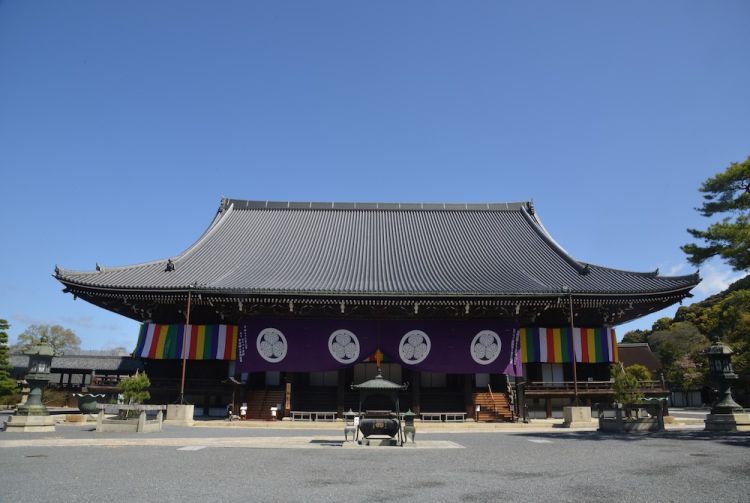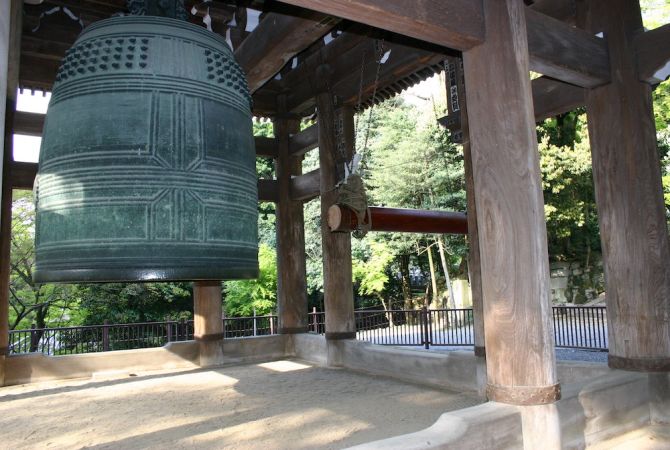A serene temple with over 800 years of history
Chionin Temple, the head temple of the Jodo-Shu (Pure Land Sect) of Buddhism, sits at the foot of Higashiyama in Kyoto. Built in the age of the samurai, its relatively simple architectural design betrays its powerful presence and grand history. Today, the temple offers rare sights to visitors from around the world, including a garden that offers panoramic views of the city and surrounding area of Kyoto.
Don't Miss
- Walk upon a corridor that once warned of intruders by producing the call of nightingales
- Observe an ancient umbrella placed in the Mieido to protect it from fire
- View the two tiles that would complete the Mieido—proof that it remains unfinished
How to Get There
Chionin Temple is accessible from JR Kyoto Station via a 15 minutes taxi ride.
If traveling from JR Kyoto Station by bus, take Kyoto City Bus number 206 and walk 5 minutes after disembarking at the Chionin-mae stop.
The temple can also be accessed by train from JR Kyoto Station by riding the Subway Karasuma line and transferring to the Tozai line at Karasuma Oike Station. Disembark at Higashiyama Station and walk 8 minutes to arrive at Chionin Temple.
Quick Facts
Chionin Temple was constructed in 1234 and later developed under the patronage of the Tokugawa Shogunate
The temple boasts one of the largest wooden gates in all of Japan
The giant bell on the temple grounds weighs 70 tons
The temple flourished under the patronage of the Tokugawa Shoguns
Chionin Temple was founded by the disciples of Honen Shonin, the founder of Jodo-Shu (Pure Land Sect), to carry on his teachings following his death. The Jodo-Shu of Buddhism teaches that all people can be saved by chanting the “Namu Amida Butsu” prayer. The main temple hall, or “Mieido,” is located on the same site Honen Shonin originally built his small hermitage to spread the teachings of the Jodo-Shu, and his remains are enshrined in the mausoleum at the far end of the temple grounds.

©chion-in
The temple grew in size and flourished under the generous patronage of Tokugawa Ieyasu after he designated Chionin Temple as his familial temple 369 years after its original construction in 1234. The spirits of three generations of Shoguns are enshrined in the Gongen-do mausoleum: Tokugawa Ieyasu (1543-1616), Tokugawa Hidetada (1579-1632), and Tokugawa Iemitsu (1604-1651), are enshrined in the Gongendo mausoleum.

©chion-in
Today, Chionin Temple is home to multiple national treasures including the Mieido and the Daishoro (Great Bell Tower), which houses the largest bell in Japan. This impressive bell is 3.3 meters tall and weighs over 70 tons—a team of monks are required to ring it each New Year's Eve. Perhaps the temple's most recognizable and sizable treasures are both the Sanmon and Karamon.


©chion-in
One of the largest wooden gates in Japan
The Sanmon is 24 meters tall and 50 meters wide. Approximately 70,000 tiles were used to cover its roof. This enormous, two-storied temple gate helps to set the tone for the scope and size of the buildings within the Chionin temple grounds proper.


©chion-in
The main temple hall, called the “Mieido,” is a national treasure and impressively large at 45 meters wide and 35 meters deep. Gorgeous and significant religious images on display in the hall include the large carvings of Honen Shonin, separated by the nightingale corridor with a distinctive sound that once warned the temple monks of intruders.

©chion-in
A garden with a view
The Hojo Garden was created at the dawn of the Edo period (1603-1867). Its careful and deliberate design that makes use of the surrounding scenery has been designated as a National Place of Scenic Beauty. Visitors who ascend the stairs at the rear of the garden will find the Santei Garden, which offers panoramic views of the city of Kyoto. The views of the city, the garden and surrounding grounds provide a sight to behold even after the sun sets. Chionin Temple also allows guests to book overnight stays.


Surrounded by famous temples and shrines
Visitors to Chionin Temple will be delighted to find that a wealth of other famous cultural properties such as Nanzenji Temple , Yasaka-jinja Shrine , and Kiyomizudera Temple are all within walking distance of the temple grounds.

























































